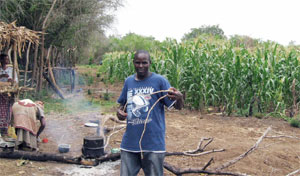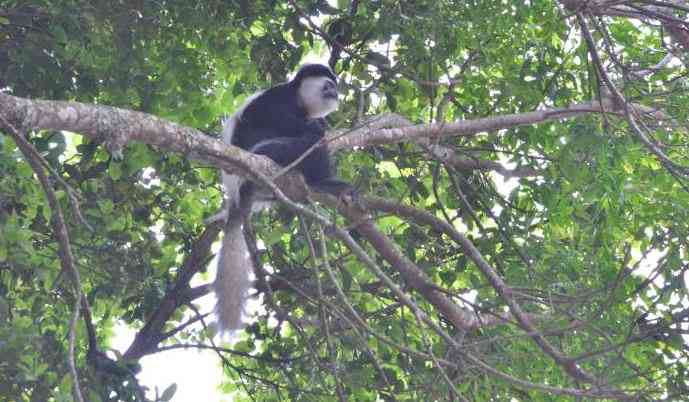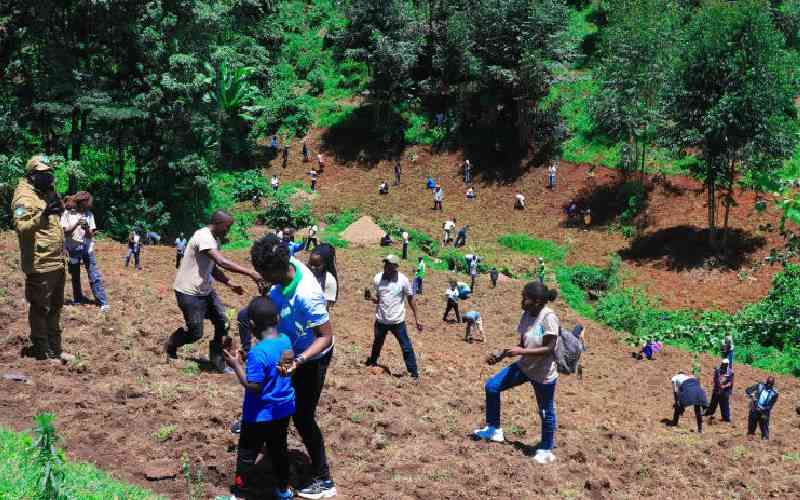By Maore Ithula
From a distance, the monkey perched on a tree branch on the edge of a forest strikes a majestic pose, its upper black colour resembling a crisp waistcoat that contrasts sharply with a lower, white abdomen.
Another primate, of a dull, grey hue stares back stubbornly from another branch. The beautiful monkey is the Tana River Colobus while the ugly species is the Tana River Mangabey.
 |
A resident of Tana River District shows a woven rope, the type that is used to trap monkeys invading farms. Photo: Maore Ithula/Standard |
The reserve that covers about 11 square kilometres is home to 46 per cent of the entire population of Tana River red colobus monkeys and 54 per cent of the mangabey monkey.
However, despite the noble cause, the foundation of the reserve has been shrouded in controversy since it was established.
The Pokomo community who are the native to the area have been demanding compensation as initially agreed between them and the Government before the reserve land was excised.
The push and pull between the community and the KWS over the occupation of the forest was taken to the court in 1976.
In 2007 the High Court in Mombasa determined that the land belongs to the area residents and barred KWS from interfering with farming activities of the residents.
Nevertheless, KWS is staying put and conservation of the animals is still continuing albeit with resistance by locals, says Kivai.
A primate census conducted by IPR in 1994 established there were between 1,000 and 1,300 of both monkey species within the reserve. A repeat of the count in 2001 posted between 736 and 838 while the latest census carried out last year established a drop of between 33 and 36 per cent of the entire population of the animals.
Alarmed by the findings, the World Bank donated Sh500 million for the relocation of people living in the conservancy to Kipini, about 200km from Hola, the Tana River District headquarters, with attractive terms of compensation.
With more donor funding expected, IPR is involved in a new conservation approach where the Pokomo community is now taking part in the process.
Stay informed. Subscribe to our newsletter
Community programme
The programme is being managed by KWS and IPR in partnership with Rutgers University (USA) and the Northern Rangelands Trust, a local NGO.
He says: "In the new approach, we are running an interactive community conservation programme. With the help of community elders, we assist members of the Pokomo community to form conservation groups," says Kivai.
 The Standard Group Plc is a
multi-media organization with investments in media platforms spanning newspaper
print operations, television, radio broadcasting, digital and online services. The
Standard Group is recognized as a leading multi-media house in Kenya with a key
influence in matters of national and international interest.
The Standard Group Plc is a
multi-media organization with investments in media platforms spanning newspaper
print operations, television, radio broadcasting, digital and online services. The
Standard Group is recognized as a leading multi-media house in Kenya with a key
influence in matters of national and international interest.
 The Standard Group Plc is a
multi-media organization with investments in media platforms spanning newspaper
print operations, television, radio broadcasting, digital and online services. The
Standard Group is recognized as a leading multi-media house in Kenya with a key
influence in matters of national and international interest.
The Standard Group Plc is a
multi-media organization with investments in media platforms spanning newspaper
print operations, television, radio broadcasting, digital and online services. The
Standard Group is recognized as a leading multi-media house in Kenya with a key
influence in matters of national and international interest.








